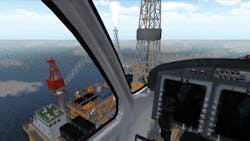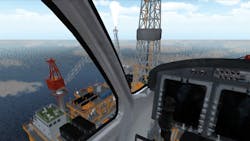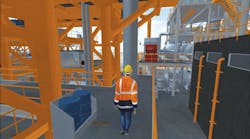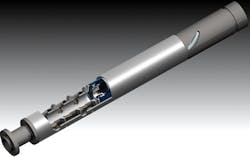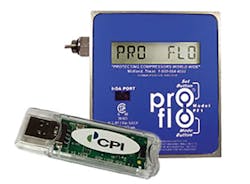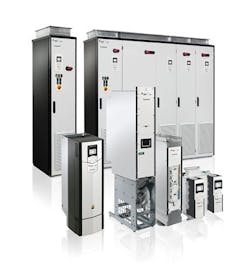New tools and technology for the offshore industry
Virtual and augmented reality offers new training tool
Vincent Higgins • Graham Mullings
Optech4D
While many associate virtual and augmented reality (AR and VR) technology with video games and simulation experiences, it is perfectly suited for the offshore oil and gas industry. Research shows that VR-based training dramatically improves retention and recall of information and events. A study by the National Training Laboratory (NTL) for Applied Behavioral Science revealed that the retention rates for lecture-style learning were at 5%, while retention from reading-based learning was at 10%. In contrast, learning by doing (where VR simulations exist) produced a 75% retention rate.
One of Optech4D’s customers, a supermajor, has reported dramatic reductions in training costs while also achieving an increase in engagement and retention rates for its offshore helicopter landing officers (HLOs). Virtual reality now delivers training that was pure science fiction a few years ago. There is now a way to virtually create fully immersive, highly realistic environments where HLOs can experience the dangers and extremes of a helicopter crash on an offshore platform - on standard desktop computers or mobile devices.
The beauty of these realistic simulations is that the trainee is allowed to make mistakes, sometimes of the life threatening variety, and experience the outcomes with no serious repercussions. Allowing officers to learn from their mistakes in the virtual world will better prepare them for the emergency should it occur, allowing them to execute the emergency action plan quickly and accurately. Metrics on the accuracy, time, mistakes and completion percentage are logged with software during training and are reviewed with the training managers. This allows users and trainers to more accurately establish pass/fail criteria. Furthermore, these technologies allow companies to track and trend retention rates, performance and identify gaps in the training program.
Field engineers and technicians rely on access to accurate documentation when operating and maintaining offshore BOPs. With the new regulations on BOP maintenance and inspection being implemented, AR is quickly becoming a must-have technology for the offshore industry. Technicians can use AR tablets and smart safety glasses to access guided work instructions during this critical process - allowing for a safer and faster turnaround time with a reduced chance of errors.
The industry has yet to see the ramifications of the new regulations with respect to the added costs and associated downtime. The question needs to be asked: Why wait for a challenge to become a problem? With AR technologies, companies can offset these added costs by giving their employees the tools necessary to be successful.
Through technology available on the market today, field technicians can communicate in real time with remote experts anywhere in the world with the push of a button. Augmented reality allows consultants to lend their expertise to field workers without ever leaving the office or their own home. Gone are the days of flying an expert to a remote offshore location for a firsthand perspective at a problem.
With onboard cameras and WiFi connectivity, AR hardware (glasses and tablets) empower field technicians to “visualize what matters” from anywhere, any time. Augmented reality compounds the effectiveness of subject matter expert advice: They can provide counsel and troubleshooting expertise to multiple projects in multiple regions in a single day. Companies will be exploring the impact of this type of technology on their state-of-the-art platforms in all offshore drilling locations - which holds promise for increasing both safety and efficiencies. All signs point to seeing more of these projects over the next few years.
As companies struggle to address the growing knowledge gap in the offshore industry, virtual and augmented reality technologies have quickly become the best and most cost-effective solutions. The time has long passed for companies to dive into the AR-VR technology experience - it is time to take the plunge to better attracting top talent and improve efficiencies through AR and VR solutions.
UPS systems provide last line of defense for platform power grids
Douglas King
AMETEK Solidstate Controls, Inc.
When it comes to power on an offshore oil rig, there is no on/off switch for crew shift changes. For safety as well as operational and productivity reasons, the flow of energy must be 24/7 and completely protected from possible blackouts and malfunctions in the main power supply caused by frequency fluctuations or lightning strike over-voltages.
Distributed control systems and other monitoring equipment are used to ensure smooth operation of offshore platforms. Navigational aid signal lights, running day and night, are essential to the safety of nearby ships, aircraft and the platform itself, which is why every rig is designed to accommodate customized, ruggedized uninterruptible power supply (UPS) systems.
A UPS system consists of one or more battery chargers, rechargeable batteries (lead acid or nickel cadmium, either flooded or valve regulated) usually installed in a dedicated room, battery health monitoring technology that includes alarm annunciators, DC and AC power distribution, along inverters for various critical loads on the platform. They are also equipped with special safeguards that will signal platform personnel when a malfunction occurs.
Since every platform is different, and every company has its own criteria for how a platform is designed and constructed, the UPS system is custom-designed to meet the project requirements. Special needs of the application, such as space, weight, and load requirements, are taken into account. Much depends on where the platform is going to be located. For example, fixed support legs are used in shallow-water areas to secure the platform to the seabed. Tethered and mobile drilling platforms used in deepwater areas have additional requirements. The cabinet containing the UPS system needs to be more robust, and greater attention is paid to corrosion prevention for the cabinet as well as all connected cables and electrical wiring. Combining flameproof enclosures with extra safe connection terminals, the UPS system is able to operate in a compact, weight-optimized installation space on the platform.
Particularly critical is the UPS’ ability to withstand the most severe environments imaginable for as long as possible. These environmental considerations, when combined with the possibilities for corrosion, dust, and atmospheric gas, electrical failures, and other unforeseen problems, can contribute to power glitches in the power grid, including the systems themselves, their batteries, and battery chargers.
To ensure a continuous power supply for the lighting of the platform, each UPS system uses a distribution panel with a parallel feed from the standard power supply and the emergency power supply.
To withstand the increased charging power while preventing corrosion and keeping safety measures at their highest levels, the UPS systems use ABF-approved epoxy coatings or nickel-plated copper bus bars, special anti-corrosion terminal connections, and acid resistant metal surface coatings. In extreme cases, the cooling air to the UPS cabinets is brought in from a clean (or scrubbed) source at a positive pressure and exhausted out of the cabinet tops to keep the salty air and high humidity from attacking the circuitry. In addition, all terminals to the UPS enclosure and to the cables that take the power to the rest of the platform must be secured and protected.
The service life of any offshore UPS system is reduced by operation in high ambient temperatures. The battery is most affected by high ambient temperatures; other internal components, such as DC bus filtering capacitors, may have their service life shortened by high ambient temperatures unless special high-temp components are selected.
That is why these offshore systems have built-in design margins to preserve the operation life in tougher environments. In addition, the equipment also will be accompanied by predictive parts replacement programs to insure high UPS mean time between failures (MTBF).
A key component of all UPS systems is a hybrid or “wrap-around” static switch. Only the bypass pole of the static switch has the inverse-parallel silicon controlled rectifier (SCR) pair for electronic power switching. The inverter side of the hybrid static switch uses a power relay with normally open contacts to disconnect the inverter from the bypass during the normal static switch critical load transfer operation.
Under critical load fault, downstream of the UPS output, the short circuit current is limited only by the impedance of the bypass source. The high fault current levels can weld the contactor’s electrical contacts closed. If the UPS hybrid static switch contactor contacts fail to open, the UPS output will be connected continuously to the bypass source. UPS inverters, especially some PWM inverters, are not designed to have their AC outputs back-fed from the bypass for more than 30-50 milliseconds.
UPS systems in offshore and other heavy-duty applications use inverse-parallel SCR devices on both the inverter and bypass poles. This modification to the hybrid static switch is a more expensive design feature, but the elimination of the contactor increases the overall static switch reliability. The MTBF of the UPS is directly linked to the reliability of the static switch, which is in the power path between the inverter and critical load.
Contingency design
Contingency design analysis is the examination of how the UPS behaves when the unexpected happens. It is common these days for UPS equipment to use microprocessor control. Unfortunately, unless careful thought is given as to how to limit the scope of microprocessor control, single point failure mode creates a problem if the microprocessor fails. In UPS designs that have not considered single point failure modes, the failure of the microprocessor results not only in the sudden loss of UPS output, but also the failure of the static switch to transfer of the critical load to the bypass.
For offshore platform applications, the UPS single-point failure modes are carefully considered and eliminated if at all possible. Both internal and external watchdog circuits monitor the microprocessor’s calculations continuously. If a microprocessor error is detected, the UPS, with its independent and fail-safe static switch, immediately transfers the critical load to the bypass.
Using a make-before-break electromechanical switch along with a closed transition manual bypass switch, the critical load switching is completely independent of the static switch operation. Furthermore, the manual bypass switch is mounted remotely from the UPS cabinet so that total UPS isolation can be provided while the UPS is being serviced.
Overall, the life expectancy of an offshore UPS system can be anywhere from 10 to 15 years.
Corrosion control coating prevents shutdown offshore Holland
Existing corrosion control solutions are time consuming, costly to apply and do not necessarily offer adequate levels of protection in offshore environments. TM198 was developed by Oxifree Global as a solution to corrosion and to drive down capital and operational costs. It is an organic, patent-protected, self-lubricating thermoplastic coating which provides complete protection against contamination and corrosion.
The product was recently used on a wellhead platform offshore northern Holland. Caused by the salty marine environment combined with the constant wet and dry conditions, wind, and changing temperatures, corrosion was clearly visible on the metal work of two wellheads, particularly around complex shapes. Two technicians attended and applied two coatings of TM198 to the wellheads, which had previously been protected with paint; this was failing under the harsh offshore conditions.
Unlike conventional coatings, where the entire surface requires sandblasting before application, preparation for TM198 is minimal. Technicians brushed down the surface with wire brushes to remove loose rust and debris, speeding up the preparation process and keeping costs down for the client.
Aluminium tape was used to cover the flange spaces to reduce material usage and again, lower costs. The entire wellhead was coated, including valves, flanges, lock nuts, and pipes. Hard to reach areas and the underside were coated first using the Polymelt 50 ATEX unit, designed especially for use in hazardous environments. Technicians applied a silicone sealant, although not essential, to provide the leading edges of the coating with added protection.
One of the main challenges faced was lack of accommodation on the platform; each day technicians had to be shuttled in and out, making logistics far more difficult and costs run high. The speed of application, tolerance to weather conditions, and minimal preparation required for TM198 meant a faster application speed- despite the challenges, both wellheads were completed in just two days.
Areas of coating can be cut away at any time for inspections and simply refilled to continue protection. It can be applied to live equipment and starts working immediately. Only thermoplastic encapsulation allows the valve actuators or stems to be protected from seizing, while allowing them to spin freely within the coating, Oxifree says, noting that the built-in oils provide self-lubrication as well.
With no shutdown necessary and minimal surface preparation required, TM198 can provides savings on maintenance costs, capital, and opex.
Baker Hughes introduces small-diameter ESP system
Baker Hughes’ CENtrilift PASS slimline ESP (electric submersible pump) system is designed to help operators optimize production and reserve recovery while lowering lifting costs in small-diameter wellbores or wells with restricted space due to casing patches or complex completion designs.
The oilfield services provider claims that it is the only small-diameter ESP system capable of operating at flow rates down to 50 b/d and that it includes a comprehensive suite of slimline gas-management technology. Although small-diameter wells are typically onshore, this system can be used in offshore applications where the completion design limits the amount of space available for the ESP system.
The new ESP system incorporates a Baker Hughes’ FLEXPumpER extended-range pump, engineered using computational fluid dynamic modeling software to provide the industry’s widest operating range for a 3.38-in. pump. The FLEXPumpER pump operates at flow rates from 2,500 to 50 b/d, mitigating the need to change out pumping systems as production rates decline. The pump’s optimized flow path also improves ESP system reliability by preventing solids build-up and abrasive wear in the pump.
The ESP system manages gas entrained in the production stream or gas slugs that break out of the reservoir. It combines natural and mechanical separation in a single design to minimize the amount of gas entering the pump, regardless of wellbore orientation. When the ESP is deployed in a horizontal or deviated orientation, gravity cups shift to block the pump inlet ports on the high side of the intake where the gas accumulates, preventing the gas from entering the pump and venting it into the annulus.
When the ESP is installed in a vertical orientation, the production stream bypasses the gravity cups and mechanical vortex gas separation technology diverts gas away from the pump and into the annulus. For applications that only require mechanical gas separation, the CENtrilift PASS system includes a vortex gas separator. Unlike rotary gas separators, the company claims the vortex design is more efficient and more effective at separating gas from the fluid before it can enter the pump.
Any gas that does enter the pump is effectively handled by combining a GI gas insurance boost pump and a FLEXPumpER pump. Both pump designs are engineered to optimize performance in the presence of gas. When the two pump technologies are deployed together, the system can handle more than 60% gas volume fractions through the pump, Baker Hughes said.
The new ESP system also extends the pressure rating of the pump to 5,800 psi, allowing the ESP to be installed deeper in the well―closer to the producing zone―for greater reservoir pressure draw down and higher recovery rates. Enhancements to the 3.38-in. series motor design improve the mechanical and electrical strength of the motor by 30%, while reducing the angle of the motor-to-cable connection to mitigate potential damage during installation in smaller-diameter wellbores.
Ryan Moore, vice president, Artificial Lift Systems, said: “The CENtrilift PASS slimline ESP system gives operators who are drilling smaller-diameter wells to drive down drilling costs or to improve wellbore stability a full range of options to maximize production at the lowest possible lifting costs―even in challenging downhole conditions.
CPI introduces products for compressor condition monitoring
Compressor Products International (CPI) has introduced the new Proflo USB-IR Adaptor and Proflo Assist Software for condition monitoring of the critical reciprocating compressor lubrication equipment used on offshore drilling platforms and floating production storage and offloading (FPSO) vessels.
The Proflo USB-IR Adaptor and Proflo Assist Software read and transfer information from the Proflo PF1 monitoring device, which records the average cycle time for each 30-minute block of lubrication system operation to a Microsoft Windows-based laptop, tablet or other USB equipped device through the use of infrared technology. The accompanying Proflo Assist Software presents the cycle time trend data to operations and maintenance personnel, delivering powerful, convenient condition-based maintenance capabilities.
The Proflo PF1 monitors a compressor lubrication system, alerting an operator or engaging shutdown protection based on the cycle time of the system. Real-time access to this information can help technicians intervene and prevent a range of problems, including the extrusion of packing and piston rings, locking of the packing case, valve stiction and more.
“Our Proflo product line has long been one of the most powerful weapons in the battle against over- and under-lubrication,” Robert Spadt, CPI Product Manager for Jubrication Products, said. “Real-time operational data is a prerequisite for any condition-based or predictive maintenance program. And the valuable condition monitoring data the system collects is now even easier to access thanks to this USB receiver and software interface.”
The software will operate on Windows versions 2000, XP, 7, 8 or 10. Each USB-IR adaptor can be used with multiple PF1 monitoring devices. Included are the USB-IR Adaptor, instructions and a download link for the Proflo Assist Software and a 6-ft USB male-to-female cable.
Energy-efficient gangway for offshore personnel transfers
Kongsberg Maritime has introduced a new gangway for its Walk-to-Work (W2W) vessels to improve the efficiency of offshore personnel transfers.
According to Srinivas Tati, the company’s VP Business Development, “W2W vessels contain many stand-alone products and solutions from various suppliers. This fragmentation often leads to inefficient and costly operations, and can even entail greater safety risks. There is a need, therefore, for greater system integration.
“The gangway on our vessels is completely integrated with the dynamic positioning system and power management. The design also features integrated HD cameras and sensors on the gangway itself, which enables faster docking and dropping off of workers on platforms, meaning that more sites can be visited in a day.”
In an offshore wind farm service context, the gangway will automatically start the docking process as the vessel approaches a turbine. Once docked, the gangway stays safely connected via the dynamic positioning system regardless of weather conditions and sea state, allowing the engineers to disembark. It can then quickly disconnect and move on to the next turbine. An integrated lift within the gangway assists lifting of goods and personnel from the weather deck, or can be integrated into the vessel’s design to move goods from below deck, making the entire operation more efficient.
“We have designed a way to harness the energy created by moving structures on board,” Tati said. “The electric motors that power the W2W gangway for instance, can generate power from the movement itself. This can then be fed back into batteries, which are integrated to the vessels systems through the power management system. We are also working on a similar system for all kinds of back deck winches.”
Bringing in power, operational modes, and handling operations offers the potential for further efficiencies. To this end, Kongsberg Maritime is partnering with contractors to help it become a single supplier for integrated onboard energy, handling, and operational systems. Over the past few months the company has formed partnerships with Siemens on variable-frequency drives and with Schneider Electric for switchboards and related systems for offshore and maritime vessels.
BP, GE launch new real-time asset management technology
BP and GE recently introduced Plant Operations Advisor (POA), a digital solution designed to improve the efficiency, reliability, and safety of BP’s oil and gas production operations.
BP is using POA to manage the performance of its Atlantis platform in the Gulf of Mexico and, subject to a successful pilot, the system will be deployed next year to other facilities around the world. Once installed, more than 20 million digital data points will be streamed live, with the aim to allow the operators to improve the efficiency, reliability, and safety of its global assets.
The tool, built on GE’s Predix operating system, was created as part of a development partnership the two companies announced in January.
Lorenzo Simonelli, president and CEO of GE Oil & Gas, said: “We are taking a big step forward together during this time of digital transformation, deploying what we’ve co-created over the past year to drive the kind of productivity improvements that the oil and gas industry needs. The global deployment is expected to be the largest-scale deployment of GE’s Predix-powered APM [asset performance management] technology to date.”
POA will help prevent unplanned downtime and improve facility reliability by helping engineering teams respond quickly to issues as they occur in real-time.
Ahmed Hashmi, BP’s Head of Upstream Technology, said: “By bringing together some of the best minds at GE and BP, we were able to develop this innovative digital product and are confident that it will have a significant impact on our business. When fully deployed, these advanced digital technologies will change the way we work and improve the integrity and performance of our assets around the globe.”
Using GE’s Predix and APM capabilities, the new technology integrates operational data from producing oil and gas facilities to deliver notifications and analytical reports to engineers with the aim of helping them to identify operational performance issues before they become significant.
The system is said to provide simplified access to a variety of live data feeds and includes visualization capabilities including a real-time facility threat display. It also incorporates an extensive case management capability to support learnings from prior operational issues.
GE said it intends to offer this technology, which combines big data, cloud hosting, and analytics on both individual pieces of equipment as well as the entire production system, as an APM solution available to the industry once the pilot has been completed.
ITT introduces intelligent variable speed pump control and protection system
ITT’s PRO Services brand has launched PumpSmart PS220, a next-generation intelligent pump control and protection solution for single and multiple pumps.
Besides providing variable speed pump control, the new system features patented pump protection technology that protects against upset conditions such as dry run, minimum flow and cavitation, resulting in improved reliability and safety of the pump systems. In addition, it also includes advanced sensorless algorithms that determine critical performance parameters and provide valuable process insight and diagnostic data. Premier process control functionality comes with robust redundancy to maximize process uptime.
Adarsh Iyengar, global director for Monitoring & Controls, said: “The PumpSmart PS220 provides the next level in intelligent pumping and sensorless technology. Accurately delivering information on key performance metrics such as flow, head, and efficiency in real time without the need of external sensors gives our customers better insight to their pumping systems.
“The PS220’s innovative features include six-pump multipump control, a flow totalizer, intelligent sleep, flow economy, and minimum flow bypass valve control. These features deliver exceptional value to our customers as they better optimize pump control strategies and lower system design and operating costs compared to other variable speed drives that have pump functionality.”
By protecting against pump failure due to process upsets, PumpSmart keeps operations running longer and reduces unplanned repair activities and expense. By right-sizing pumps to the systems they are running, the new system can reduce not only energy consumption, but also wear and tear on the process systems.
